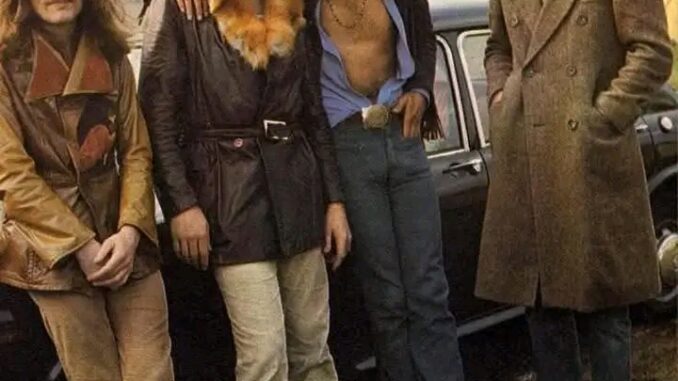
The song Stairway to Heaven originated in 1970 when Jimmy Page and Robert Plant spent time at Bron-Yr-Aur, a remote cottage in Wales, following Led Zeppelin’s fifth American tour. According to Page, he wrote the music “over a long period, the first part coming at Bron-Yr-Aur one night.” He always kept a cassette recorder nearby, and the song gradually came together from various taped ideas.
Certainly! Here’s an expanded 800-word version about the origins of “Stairway to Heaven”:
—
**The Origins of “Stairway to Heaven”**
“Stairway to Heaven” stands as one of the most iconic and enduring songs in rock history. Its intricate composition, poetic lyrics, and profound musical progression have captivated audiences since its release in 1971 as part of Led Zeppelin’s untitled fourth album. But behind its legendary status lies a fascinating story of inspiration, creativity, and collaboration, rooted in a specific period in the band’s history.
The genesis of “Stairway to Heaven” dates back to 1970, a pivotal year for Led Zeppelin. Following the completion of their fifth American tour, the band retreated to a remote cottage in Wales called Bron-Yr-Aur, a secluded haven nestled amidst the scenic valleys and rugged mountains. The cottage’s serene environment provided the perfect setting for musical reflection and experimentation, away from the hustle and bustle of fame and touring.
Jimmy Page, the band’s guitarist and primary composer, and Robert Plant, the lead singer and lyricist, sought inspiration during their stay at Bron-Yr-Aur. Page, in particular, was eager to explore new musical ideas and melodies, which would eventually coalesce into one of their most famous compositions. According to Page, the initial musical ideas for “Stairway to Heaven” began to take shape during this period. He recalls that he “wrote the music over a long period,” with the first parts coming to him one night at Bron-Yr-Aur.
Page was known for his meticulous approach to songwriting. He always kept a cassette recorder nearby, capturing snippets of melodies, riffs, and musical ideas as they came to him. This practice proved invaluable, allowing him to record spontaneous inspirations that might otherwise be lost. Over time, these taped ideas were layered and edited, gradually taking on a more cohesive form.
The composition of “Stairway to Heaven” was a gradual process that spanned several months. The song itself is notable for its structure—a slow, contemplative introduction building into a powerful climax. The intro features an acoustic guitar motif that sets a mystical tone, with lyrics penned by Robert Plant that evoke themes of spirituality, longing, and introspection. As the song progresses, it transitions through various musical phases, incorporating electric arrangements, a soaring guitar solo by Page, and a memorable vocal performance by Plant.
The lyrics of “Stairway to Heaven” are rich with symbolism and poetic imagery, which Plant crafted to complement the song’s mystical quality. The narrative is often interpreted as a journey toward enlightenment or self-discovery, a reflection of the band’s interest in spiritual and philosophical ideas during that era. The phrase “there’s a lady who’s sure all that glitters is gold” hints at materialism and the search for higher meaning beyond superficial pleasures.
The recording process of “Stairway to Heaven” was as methodical as its composition. Led Zeppelin recorded the song in various sessions at Island Records’ headquarters in London, experimenting with arrangements and instrumentation. The band’s close collaboration and improvisation were crucial in shaping its final form. Page’s layered guitar work, combined with John Paul Jones’ keyboards, John Bonham’s dynamic drumming, and Plant’s evocative vocals, created a complex and powerful musical tapestry.
“Stairway to Heaven” was ultimately released in 1971, becoming a centerpiece of Led Zeppelin’s live performances and a defining track of the era. Its popularity soared, and it became a symbol of rock music’s artistic potential. Over the years, the song’s influence has been profound, inspiring countless musicians and listeners worldwide.
Despite its acclaim, “Stairway to Heaven” has also been the subject of controversy, notably regarding allegations of musical plagiarism. Some critics and musicians claimed that elements of the song’s melody were derived from earlier folk and rock tunes. Nonetheless, the song’s originality and artistic depth remain widely appreciated.
In essence, the origins of “Stairway to Heaven” reflect a confluence of inspiration, patience, and artistic exploration. The peaceful setting of Bron-Yr-Aur served as a catalyst for Page and Plant to craft a song that traverses musical and lyrical landscapes—an enduring masterpiece born from a moment of creative retreat. Through years of refining taped ideas, improvisation, and collaboration, Led Zeppelin created a song that continues to resonate with audiences, inviting them on a mystical journey up the metaphorical stairway to enlightenment.
If you’d like a more detailed or specific aspect of the song’s history, feel free to ask!
Leave a Reply